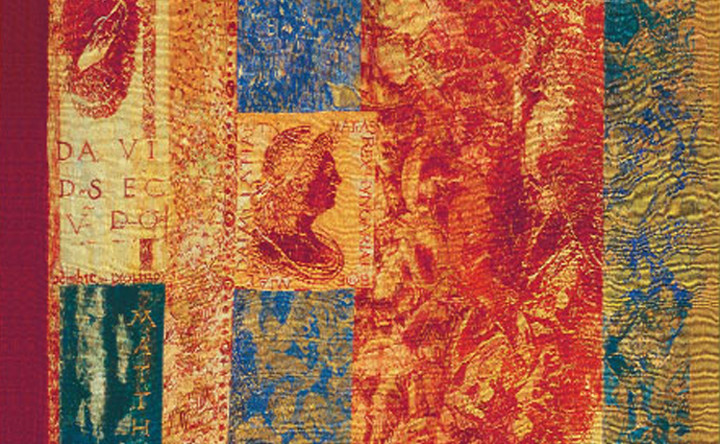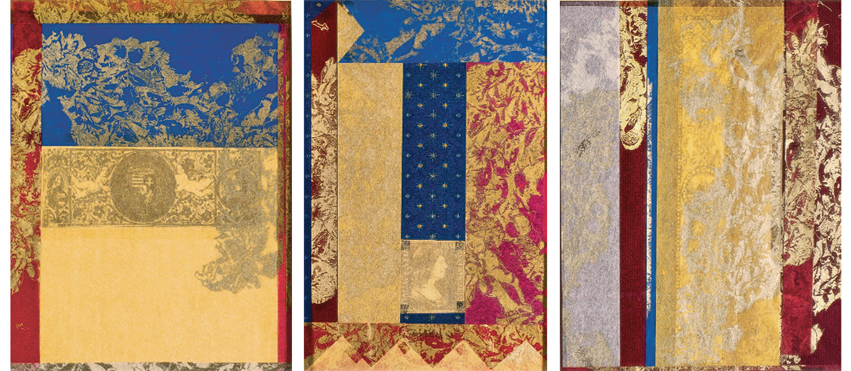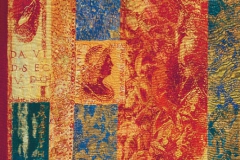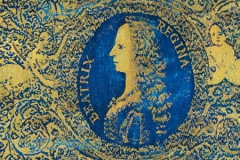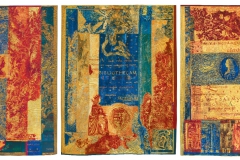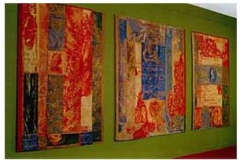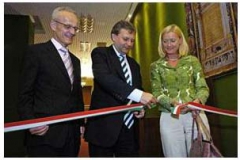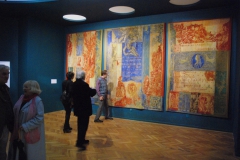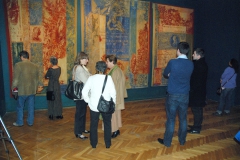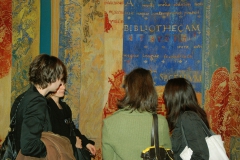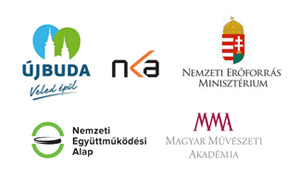Készült: 2003-2006
Budapesti Széchenyi Könyvtár tulajdona: Haute-lisse, 300x210, 300x250,300x210 cm
Transzcendens térképek és történelmi tablók
A Corvin kárpitok a reneszánsz uralkodó szellemiségének állít emléket
Balogh Edit, Baranyi Judit, Benedek Noémi, Bocz Beáta, Csókás Emese, Dobrányi Ildikó, Erdélyi Eta, Fóris Katalin, Hegyi Ibolya, Harmati Zsófia, Kecskés Ágnes, Kiss Katalin, Kneisz Eszter, Kovács Péter, Köllő Margit, Kőszegi Anna Mária, Kuchta Klára Lencsés Ida, Martos Katalin, Máder Indira, Mészáros Erzsébet,Nagy Dalma, Novák Ildikó,Nyerges Éva, Pasqualetti Eleonóra, Pázmány Judit, Rapaich Richard, Sipos Éva, Solti Gizella, Szabó Verona, Száraz Mária, Tápai Nóra, Vajda Mária, Zelenák Katalin
Van abban valami jelképes protestáló heroizmus, és az idő sodrával szembeforduló időn kívüliség, ha a kézi szövés, az ősi technika alázatával hónapokig a felvető szálaira feszített figyelemmel dolgozik számos neves művész. Különös lelkierő kell hozzá, a kép él a szövőben, s a karton segít kitartani, a színkódok támasztékot adnak, de a megszövendő, és a hozzárendelt épp aktuális mozdulatsor az alkotás frontvonalára feszítve. Az események színtere a szinte lőrésnyi kémlelő ablaknyi felület, ahol színben, pontokba szorított rajzban és felületben történik a mű, miközben az egész, mint félmúlt, s közeljövő rejtve marad, s csak a levágásnál tárul fel.
A szövés az ima rokona, magasztos alulnézet, ahol a szellem ismeri az egészet, számon tartja, de a kéz a felvetőszálak által megjelölt pontokban szervezi a vonalat, és a szövés sorról-sorra építi a kép síkját, hogy aztán a térbeliségen átszökve a transzcendens dimenziójába emelje a szemlélőt majd a kész szőnyeg. A művésznek jelen kell lenni a rejtettben, és uralnia a megnyilvánultat. Bujtatott, levert fonaljelekből áll össze a szövet képi szövege, a „parole”, a szövő beszéde maga a mű, a mindig egyszeri, de időben mindig újralátott és újjáértett szőnyegnyi teremtés, mellyel a kései szemlélő mindig egyedi dialógusba keveredik. Így munkálkodik együtt sok szuverén alkotó a közös terv papírvázlatára vetülőárnyékos alázattal ama nagy uralkodó hajdani könyvtára igézetében, egy olyan korban – melyben a könyvet is i-Padon, tableten, netbookon olvassák, ha olvasnak, hiszen az esszéista Susan Sontag szerint már nem élünk irodalmi korban.
A Corvin kárpitok a közösségbe fogó művészi alázat tisztelgése Corvin Mátyás és Corvinái, egy olyan uralkodó és hatalom előtt, melyben igazság, szellem és biztonság egy volt, és olyan könyvek előtt, melyek egyediségében az alázat, minőség és a szinte égi nagyszerűség együtt állt. Az alkotó közösség egységbe fogó invenciója, és a nagyszerű egyéni alkotások szabad művészeinek önkorlátozó fegyelmezett alázata, és anonimitása rokon a hajdani scriptoriumok kódexfestőinek alázatával, és szakrális minőség igényével. A Corvin kárpitok nem előzmény nélküli az egyetemes magyar kárpittörténetben, és a Magyar Kárpitművészek Egyesületének is harmadik nagy vállalkozása. Ez a közös mű a magyar államiság, szellem és történelem, a magyar múlt történelmi pilléreit megjelenítő sorozat fontos eleme. A magyar kárpittörténet fontos munkái, mint afféle széttagolt ikonosztáz elemei kötik össze szent helyeinket, mint az Országház, az esztergomi Bazilika és a Keresztény Múzeum, vagy a hajdani királyi vár területén otthont kapott Széchényi Könyvtár.
Amikor az első közös mű, a Kárpit határok nélkül 10.5 m2 kárpitja elkészült, valójában e munka megszülte magát és az egyesületet is. E munkához kapcsolódóan jött létre az egyesület negyvenhat alkotó közös óhajaként, melyhez a szakma szinte minden képviselője csatlakozott, belföldön és külföldön egyaránt. Ezt követte a Budavári Kárpitműhely megalapítása, melyben a második közös mű, az esztergomi Bazilikában felszentelt Szent István és műve című 18 m2-es millenniumi kárpit elkészült. A Széchényi Könyvtár budavári épülete fogadta be a Corvin kárpitokat, mely a reneszánsz uralkodó szellemiségének, történelmi szerepének – metafizikai aspektusoktól sem mentes – emléket állított. Méltó épületek, színhelyek a befektetett munka léptékében arisztokratikus, és a névtelen középkori alkotók alázatával, és méltóságával készített alkotások számára. Ebben a folyamatban egyesül az alkotói személyesség és az ilyen nagy kárpitok alkotásában résztvevő szövőközösség együttműködő szorgalma, fegyelmezettsége, és közösségi szelleme.
Ami a középkori műhelyek örökségétől, hagyományától eltér, az a szuverén alkotók individualitását tisztelő és érvényesítő munkája a kezdettől a műtárgy kiállításig, ahol a közösségi szabályok és az egyéni invenció egységét tisztelő szempontok kényszere már a tervezésre, a motívumgyűjtés, a tervrajz változatok versenyeztetési szakaszára is igaz. Az egykorú motívumok, ikonografikus elemek, szimbólumok, relikviák, szövegek válogatása, és színvilág összeállítása közösségi erőpróba is. A tervezési szakasz, teremtő gazdagsága tükröződik a mintegy 34 vázlatterv együttesében, melyet az alkotók több alkalommal is kiállítottak, így a 2001. évi Budapesti Tavaszi Fesztivál alkalmával a hajdani Budavári Kárpit műhelyben rendezett Corvin kárpitok, Corvin Mátyás Európa-hírű könyvtára és a kortárs magyar kárpitművészet című kiállításon, később a Vizivárosi Galériában és Pápán.
A Budapesti Tavaszi Fesztivál 2008-as eseménysorozatának egyik kiemelkedő eseménye a Corvin kárpitok tervpályázatainak – motívumgyűjtési, tervezési, előkészítési folyamatának – bemutatása. Ősszel a reneszánsz év alkalmával, az elkészült művet kiállították a Nemzeti Múzeumban. A Corvin kárpitok a Széchényi Könyvtár számára készült, és a tervek végső kiválasztásában is részt vett a megrendelő, az Országos Széchényi Könyvtár szakemberei és a művészek részvételével végül nyolc tervet vettek az alkotók figyelembe, melyekből a végső zsűri számára négy változatot rajzoltak meg.
A Martos Katalin és Balogh Edit munkái alapján újra gondolt kompozíció került kivitelezésre. Második terv Csókás Emese, Kovács Péter vázlatai alapján készült. Harmadikat a Benedek Noémi, Szabó Verona csoportja alkotta, míg negyedikként a Kneisz Eszter, Mészáros Erzsébet munkái szerepeltek. A közel 20 m2 karton a kiválasztott terv alapján 2004-ben készült el. Két hét méteres és egy öt méteres szövőszéken folyamatos munkával készítették a művészek a két szimmetrikusan fekvő 300 x 200 cm és a 300 x 250 cm nagyságú középső műveket. A kész művet 2006. júniusában avatta fel az Országos Széchényi Könyvtár Bibliotheca Corvina emlékére rendezendő kiállításon a Nemzeti Kulturális Örökség Minisztérium támogatásával és a Kulturális Miniszter méltató szavaival. A megnyilvánult és az elrejtett térképezése
Az Egyesület egymásra épülő nagy kárpitjai két irányt foglalnak egységbe: az egyik a téma körüli művészet- és szellemtörténeti jelek, ikonok, szimbólumok feltérképezéséből szövődő kortükör, művészettörténeti “biblia pauperum”, melyet a képi textualitás sajátos ökologikus feszültségébe von a stílusban, formálásban, rajzalkatban is változatos alkotógárda együttessége. A Szent István kárpit motívumrendszerében is megéljük ezt a polifon, és az ezredvég képi világát is jellemző montázsszerű képszervezést, csakúgy, mint a Corvin kárpitok ikonikus organizációját éltető alkotói logikát. Ismert, a történeti emlékezet képi kánonjából átvett arcképek szövődnek kutatásértékű leleményekkel, és vizionárius, személyes ihletű „újra- ¬¬-feltalált” történeti emléknyomokkal. Egy-egy ilyen enigmatikus elem szinte misztikus-mitologikus magaslatba emeli a megszőtt történeti emléktablót, mint amilyen a Köpenyes Madonna középpontba állítása, „axis mundivá” emelése a végítéleti idők menedékeként, vagy Hunyadi Mátyás könyvtárának mennyezetéről a Corvin kárpitba átemelt, és a hajdani nagy király születését és élettörténetét uraló csillagjegyek képe. Ezek a kozmológiai léptéket kölcsönző elemek emelik a történeti tabló, az hommage műfajok, és a historizáló emléknyomokat dekoratív felületté szervező eklekticizmus fölé az Egyesület munkáit.
A képek, az írott történeti dokumentumok, kódexelemek, „mille fleur” jellegű iparművészeti utalások, a díszítőelem közlésértékű jellé alakítása és az egykorú kozmológiák ikonikus idézeteinek sajátos szemiózisa nemcsak az adott kor, s róla alkotott sztereotípiák feszültségterét szervezi meg a síkban, de textillé lett kognitív térképet szőnek tárgyukról, s egyben tükröt tartanak elménk működésének is. A szőnyeg szövete a képek szintaktikus rendbe szerveződő beszéde révén jól olvasható szöveggé alakul, ahol a hajdani és mai képírók időt, távolságot zárójelbe téve üzennek közösen. A Corvin kárpitokhoz vezető út 34 triptichonja kódex-képelemeivel, egykorú reneszánsz városképeivel (Bocz Bea), architekturális idézeteivel, Corvina iniciálé ikonosztázaival (Vajda Mária), vagy mint Harmati Zsófia munkájában a reneszánsz kazettákba foglalt képjátékán is átütő szakralitás áldozatképével önálló műegyüttest szervezett az elfogadott és megszőtt mű köré.
A közös képnyelv egysége szemünkbe tűnik még akkor is, ha ennek a konvergens képi nyelvnek a tartományhatárait a markánsan sajátos munkák jelölik ki, mint Erdélyi Etának a kódex és a heraldika ikonikus találkozását puritánul és sejtelmesen megjelenítő vázlata, melynek tündéres, angyali párját látjuk Kecskés Ágnestől, vagy az expresszív absztrakció példájaként Sipos Éva vagy Kuchta Klára triptichonjai. Ha az Egyesület első munkájában a tagok invenciójának változatos lenyomatát a bordűrben találjuk, akkor a Corvin kárpitok esetében a szuverén triptichon vázlatgyűjtemény az, ami az alkotó csoport invenciógazdagságát dokumentálja.
A Szent István és műve és a Corvin kárpitok képszervező logikája a konkrét térképkészítés alakját ölti, hogy e sajátos műfaj szövetével szóljon téren és időn kívüli dolgokról. Ilyen mű a Kárpit határok nélkül, mely a történeti Magyarország egykorú térképének történelmi sebeket gyógyító képével, e négyzetekre szabdalt kép szinte mágikus összevarrásával, és a magyarság zömében szakrális jelentést hordozó motívumkincséből összeállított bordűrjével egységbe fogott kép egyben felmutatás is, Mária országa. A Szent István és a Corvin kárpitok megalkotását követő, azaz a magyar történelmi szuverenitás két pillérét megjelenítő munkákat övező másik térkép, a 2010-ben elkészült Európa kárpit, a földrészt mutatja éjjel, ahogy azt az európai városok, települések és az összekötő úthálózatok mesterséges földi fénye betölti, telerajzolja. A mitologikus motívum-kontraszt itt sem marad el az Európát elrabló többjelentésű bika szimbolizmusával.
A szőnyegbe szövött, és tipográfiájában is jelentés-gazdag szövegek, a mitológiai és a bordűrbe szőtt asztrológiai mintázatok a maga kulturális geográfiai valóságosságában is dekoratív képi világot a közösség által használt vagy elfelejtett, de mégis máig is érvényes mitológiai-kozmológiai térbe emeli, mely alkotói beszédmód e közösseg elidegeníthetetlen sajátja, visszavonhatatlanul kijelölve helyét a nagy alkotó műhelyek sorában. Az időtlenre nyíló történetiség A használt képnyelv másik sajátossága a dimenzióköziség a konkrét és az absztrakt, az ikonikus és a szövegszerű, a sík és a felületi játékokból, fakturális felületi dinamikából adódó térbeli között. Ugyanez a poliszém többszólamúság jelenik meg a képelemek kozmológiai egymásmellettiségében.
Mintha csak Alfred Schutz fenomenológiájának továbbgondolásával jeleznék a szerzők, hogy a többszörös valóság nemcsak létgyakorlatunk szeleteinek egymásutániságában jelenik meg, mint azt a műkritikussá, vagy művészettörténészi szerepet öltő alkotó megtapasztalhatja, vagy posztmodern élethelyzeteink rövid tartamú stanzáihoz rendelt megéléseink mutatják, hanem ez a radikális eklekticizmus létünk és a megélhető, és lefesthető világunk közös jellemzője. Nem multikulturalitásról van szó, hanem a József Attila által elbeszélt „idő egészéről”, a múltak és jelenek ökológiájáról.
Ezt a szervesedő szellemi jel-ökoszisztémát tovább erősíti a tervező és kivitelező alkotók sokszólamú, de mégis egységbe szövődő invenciója, és a szövet faktúrájában testet öltő stílusgazdagsága. Az alkotó kéz misztériuma jelenik meg a közös szőnyegekben, csakúgy, mint a grafológia által feltárt írásjegyekbe foglalt személyes lelki, szellemi és testi univerzumok mögöttesében. Ezek a munkák maguk teremtik meg e művek Walter Benjamin-i értelemben vett nichét, és auráját. Így például a Kárpit határok nélkül bordűrjében foglalt szimbólumgyűjtemény maga az elbeszélt magyar mitológia. A szimbólumok maguk is egy újra feltalált történelem és önazonosítás tablójaként működve tartanak rokonságot a kálvinista templomok kazettás mennyezetével.
Minden ikon más és más, magán viselve alkotója karakterét, és a jelhez való viszonyát is, de keretté szervezett mennyövként kerítik el a profán környezettől az így megszentelt helyként megmutatott határok nélküli, de a Szent által mégis határolt hazát, melyben a földön megnyíló fénykereszt súg nekünk a Máriához tartozás golgotás titkáról. Az egyik, Hager Ritta által készített térképmezőbe szőtt kereszt maga is rokona az ausztriai, eisenbergi apokaliptikus jelnek, az 1956-ban sajátos földi-égi „land-art-szerűen” kikopott, és növénynek, magnak ellenálló kopár kereszt alakú földszeletnek, melyről látnoka azt a hírt kapta, hogy azt csak a végidőkben növi be újra a fű. Eltelt fél évszázad és az időközben zarándokhellyé lett és kovácsoltvas míves építménnyel határolt csodás helyet mára benőtte újra a fű.
A Kárpit határok nélkül fénykeresztje azonban az időtlenre nyílik. Másként jelenik meg ez az idéző erő a Corvin kárpitokon, mely egyben tisztelgés az ornamentika ereje, a míves díszítmények, tipográfiai elemek „ikonikus szertartás-világa”, a szép előtt. Az igaz, a szép és a jó trinitása így lesz egyben esztétikai törvény, az egyesület alkímiai titka. A mű dolga, hogy szemlélőjét emlékeztesse létének titkára, az időtlenre és a határtalanra. Ezek a művek Veronika kendőként őrzik történelmi létünk fordulóinak lenyomatát, kereteit, az időtlenre és a határtalanra nyílnak.
Baji Lázár Imre
- Balogh Edit
- Martos Kati terv
- Benedek Noémi terv
- Szabó Verona terv
- Csókás Emese terv
- Kovács Péter terv
- Kneisz Eszter terv
- Mészáros Erzsébet terv
- Baranyi Judit terv
- Bocz Bea terv
- Dobrányi Idikó terv
- Fóris Katalin terv
- Edréyi Eta terv
- Harmati Zsófia terv
- Hegyi Ibolya terv
- Kecskés Ágnes terv
- Kuchta Klára terv
- Lencsés Ida terv
- Máder Indira terv
- Pázmány Judit terv
- Rapaich Richard terv
- Sipos Éva terv
- Solti Gizella terv
- Solti Gizella terv
- Vajda Mária terv
- Zelenák Katalin terv



